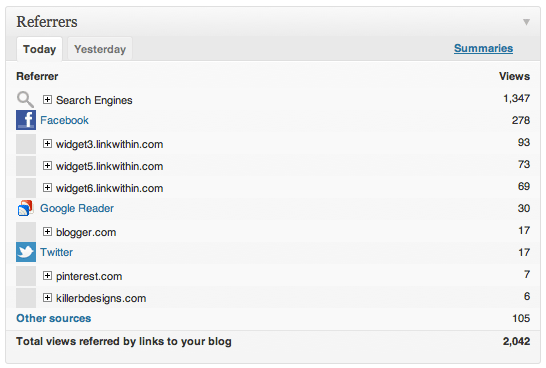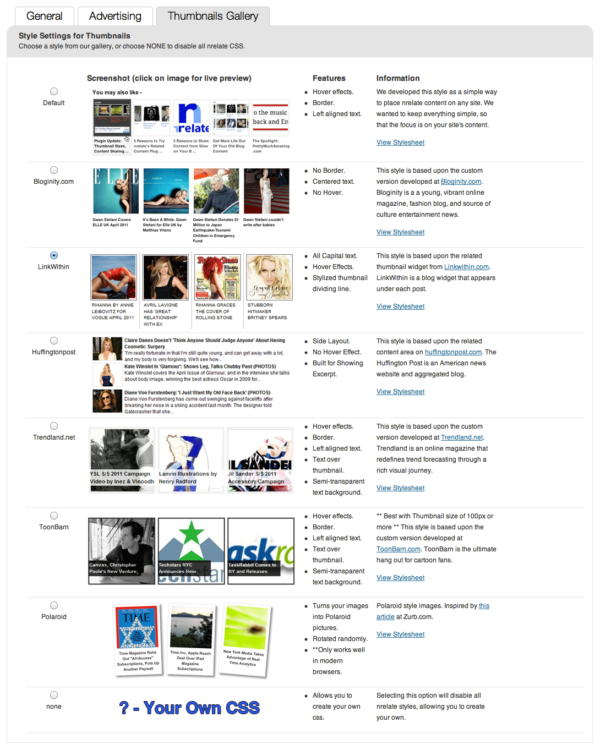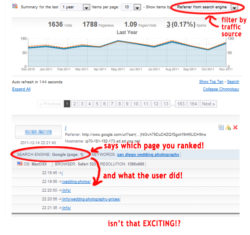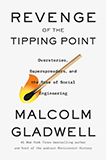***Update: with the recent discontinuation of nRelate, I have switched over to Contextual Related Posts. (You can see it in action at the bottom of this post!) I was able to customize the widgets fairly easily, and the matching algorithm is probably the best I’ve ever come across!
Welcome to this installment of Bloggy Thursdays, where I share with my fellow bloggers tips and tutorials to maximize and better your blog. While I do not consider myself an expert, I do like to think that after 10+ years of blogging — in addition to my technical knowledge — I know more than the average blogger when it comes to making your blog more appealing to readers.
Do you have any comments, questions, or topics you’d like to see covered here? Please send me a message via my contact form. Enjoy!
While doing some research for today’s Bloggy Thursdays, I stumbled upon an interesting piece of information: LinkWithin, one of the most popular “Related Links” widgets — and certainly a tool that many of my blogger friends use — is not recommended for SEO purposes.
Why? Essentially, LinkWithin is a parasitic widget. The way it works is by redirecting your traffic through their own site, effectively linking to themselves from all over your site and then 301 directing the user back to your site, thus stealing your internal link juice.
(To find out why internal links are important in SEO, check out “The Importance of Internal Linking” at Dragonfly SEO.)
Some of the websites that wrote about this issue stated that LinkWithin has started to do away with this practice, but I still saw it in effect on this blog, under the “Referrers” tab of my stats page:

See all the views from “widget3.linkwithin.com” and similar?
Aside from SEO issues, I also did not like the fact that LinkWithin’s extra step of redirecting traffic may cause visitors additional delays.
So what’s a blogger to do?
If you are using WordPress, one easy step is to install the popular Yet Another Related Posts Plugin (YARPP). However, the biggest drawback to this plugin is that while it does provide templates, it can still be difficult to configure and customize the output, especially if you aren’t familiar with PHP and/or CSS.
Another good option is Outbrain, which is used by some of the most popular sites on the web, but this service requires that you receive more than 500,000 visitors a month.
This is when I came across nRelate’s Related Content widget.
(And for non-WordPress bloggers, nRelate is also available for Blogger and Tumblr! They are also in the process of rolling out versions for Drupal, Typepad, and others!)
Installing nRelate is as simple as installing any other WordPress plugin: just download, install, and activate. And unlike LinkWithin, nRelate has an extensive options panel built right into WordPress’s admin.
And here is where you can experience the best part about nRelate — all the customizations! You can:
- change the size of your thumbnails
- easily change the title for the related content box
- specify a default image for when the post does not have any images
- choose your level of relevancy
- choose to exclude certain categories
- …and much, much more!
You can also choose from a list of seven different styles for your thumbnails, which you can further customize via CSS, or create a completely customized style yourself.
nRelate also has an optional advertisement program that can earn you some money by inserting custom ad spaces within your related content. The best part is that it allows you to configure not just how many ad spaces to include, but also the location such as before or after your own related post content, or have the location randomized. (I will not be employing this at the time, but I may consider it in the future.)
Another great product that nRelate offers is its Most Popular widget, which does exactly what its name implies by displaying thumbnails (or even just text links) just as its Related Content widget does.
nRelate needs at least 2 hours to index your site and for its widget to start appearing — and since I currently have 1,625 posts on this blog 😯 — it hasn’t started to show up on my site yet. However, you can see an example via their site, or just by Googling “nRelate examples.”
If what I have read online is true, the Related Content widget will start working flawlessly as soon as nRelate finishes indexing my site. I will definitely post a follow-up to this post if I find nRelate unsatisfactory in any way!
Update, December 2014:
Many nRelate users (including myself) were dismayed to find that nRelate will be closing its doors come 2015. After doing much research — and trials! — on the subject, I have decided to switch to Contextual Related Posts. It is free to use, and the algorithm is better than anything I’ve seen yet.






 I like books, gadgets, spicy food, and art. I dislike shopping, hot weather, and the laws of entropy. Although I am a self-proclaimed computer nerd, I still have a love for handbags and makeup... and I am always teetering on high heels. To learn more about me, visit the
I like books, gadgets, spicy food, and art. I dislike shopping, hot weather, and the laws of entropy. Although I am a self-proclaimed computer nerd, I still have a love for handbags and makeup... and I am always teetering on high heels. To learn more about me, visit the 


Excellent and very informative. I came across your post after my LinkedWithin appeared not to be working on my blog. So glad I’m well informed about a better option!
[…] Caso queira personalizar alguma formatação, você pode instalar plugins. Por exemplo, para que sua página inicial (ou de categoria) mostre um resumo dos posts (em vez de mostrar o post inteiro), você pode utilizar o plugin auto excerpt everywhere. Esse plugin inclusive conta com opções que definem a imagem destacada do post como uma pequena imagem ao lado do resumo (thumbnail). Para tirar a imagem destacada de cima do resumo (e do post também), você pode apagar a linha contendo a função the_post_thumbnail() no arquivo content.php. Já para deixar ícones de conteúdo relacionado ao post, pode utilizar o nRelate Content. […]
Thank you for writing this post! I Was about to go about setting up LinkWithin, but you’ve sold nrelate to me in a matter of minutes! Thanks again.
(I’ll search for any follow up nrelate posts you might have made since posting this!)
Thanks for this! I was having trouble with LinkedWithin not updating and I didn’t love that you couldn’t customize it at all. This looks like a much better option. Going to give it a try!
GREAT tip, thanks soooo much! Found your post among B School on FB and will share, this is VERY helpful. I’ve been using YARPP and will change this out. Really love your comprehensive description and examples, VERY well done!
Hi there! I know this is kinda off topic however , I’d figured
I’d ask. Would you be interested in trading links
or maybe guest authoring a blog article or vice-versa?
My blog covers a lot of the same subjects as yours and I believe
we could greatly benefit from each other. If you happen to be interested feel
free to send me an e-mail. I look forward to hearing from
you! Great blog by the way!
You’re a life saver, thank you thank you!! You’re right nrelate is so much better and easier to be applied on my blog~
Nice explanation. Quick addition so people know what they’re getting into 🙂
Since May 2013 NRelate loads tracking cookies from ComScore (scorecardresearch.com) which are reported by many users as malware – here’s their disclaimer (well hidden at the bottom of the page) – http://wordpress.org/plugins/nrelate-related-content/faq/. It also adds additional loading time to the entire site. Find it here – http://tools.pingdom.com/?url=geekinheels.com.
wow…glad i came across this blog post. i just clicked on a link in my own blog and it does ineed shouw in the url bar as as a linkwithin url before redirecting. going to remove that from my site right now and add something later on. thanks.
I used to like linkwithin. Let me try out nrelate. Thanks for the great information, its so convincing
thanks i just installed nrelate..hope it works fine
Thank you for sharing this information, I have been trying to gain more traffic from SEO and you are right the Linkwithin is a disservice to my users and SEO. Thank you for suggesting this plugin. I just installed it on my blog and removed Linkwithin.
Thank you for this info, I will try thisin my blog
Thank you so much for this post! It seems every time I run into a blogging problem, your site has an answer! xD
Just wanted to say thank you! It works great!!
You just saved me from passing on link juice. Using nRelate now. Linkwithin people are too clever.
Very helpful! I’ve been toiling over which plugin to use all day, so I’m glad to find a thorough review!
I know this is an older post from you, but I was wondering whether you have any newer info on Linkedwithin. I am using nRelate for WP, and I’ve been very disappointed by it. It often doesn’t post the best related content, and it only chooses from recently post content rather than going back through past posts that would be better choices. So I’m looking for something new to try.
I agree with you Allison. I have just removed nRelate from my WordPress.org site as it slowed it down to a level where it was putting off people from reading. The thumbnail images also kept appearing as grey or partially grey, and the same few links to recent posts kept being put up up again and again, whether they were relevant or not.
I’m also looking for a better alternative – do let me know if you find one, and I’ll do the same!
I’ve been thinking of adding a related posts plugin and nRelate gets lots of positive coverage.
“Installing nRelate is as simple as installing any other WordPress plugin: just download, install, and activate. And unlike LinkWithin, nRelate has an extensive options panel built right into WordPress’s admin.”
Sounds good to me – the last thing I want to do is spend ages configuring the plugin.
Once it’s installed you do have to spend time configuring nRelate to make it look the way you want it to.
Thanks for the tip! I was having a lot of trouble with LinkWithin anyway, and this seems like such a great option.
you can alternatively set nRelate on your Blog which is way better then LinkWithin.Here is the link of complete post explaining every process step by step. nRelate also offer you to earn some money by showing ads on your Blog or website.
http://sarcaassm.blogspot.com/2014/02/setup-nrelate-widget-to-your-blog.html
I started using nRelate after reading this blog. Thank you!
I can’t thank you enough for this post, I have now swapped to nrelate myself and have never been happier!
Very good information. Lucky me I came across your site by chance (stumbleupon).
I’ve saved as a favorite for later!
Thank you so much for sharing about the other sites as I could not get Linkedwithin to work!
I used linkwithin before but I stopped. I’m using Shareaholic now but I’m not sure if I should be using that too. I guess it’s time to try nRelate.
I was using LinkWithin, but now I will switch over to nRelate. Thank you.
I was using LinkWithin, but now I will switch over to nRelate. Thank you.
Thanks for the post. I didn’t realize Linkwithin redirects traffic. Will move to nRelate now 🙂
[…] Geek In Heels said: While doing some research for today’s Bloggy Thursdays, I stumbled upon an interesting piece of information:LinkWithin, one of the most popular “Related Links” widgets — and certainly a tool that many of my blogger friends use — is not recommended for SEO purposes. Why? Essentially, LinkWithin is a parasitic widget. The way it works is by redirecting your traffic through their own site, effectively linking to themselves from all over your site and then 301 directing the user back to your site, thus stealing your internal link juice. […]